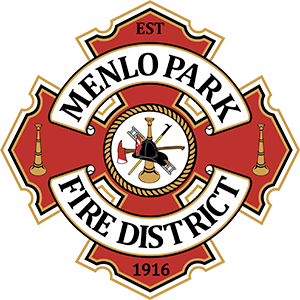In 1989 the Menlo Park Fire District increased the size of the Fire District when it assumed the responsibility of providing service to people using the baylands and water ways bordering the District.
In 1991, the Palo Alto Fire Department joined the effort to develop a water rescue capability with the Menlo Park Fire District. They formed under a joint powers agreement, what is now known as the South Bay Water Rescue Team. In 1992 the team took delivery of an 18' Panther flat bottom air boat and a 16' Avon rigid hull inflatable boat with a 90 horse power outboard motor. The air boat is housed at our new Station 77 and the R.I.B. is housed at Station 3 in Palo Alto.
The air boat is a 18'8" long, 8'4" wide, 9' high painted aluminum boat. The airboat bottom is covered by three 1/4" replaceable polymer sheets. The sheets allow the boat to easily slide over mud, grass, tulles, wood and rocks with minimal damage. It is powered by a Chevy 350 V-8 (385h.p.). It has dual wood props for reduced noise and increased top end. The boat can achieve speeds of 35-40 mph on the water and over 50 mph on the mud.
There are approximately 35 personnel that participate on our local Water Rescue Team. All personnel are required to pass an annual swim test. The swim test consists of a 500 yd continuous swim, tread water for 15 minutes, the ability to use throw-able rescue devices and retrieve a 30 lb weight off the bottom of a pool, among other things.
Of the 35 personnel, approximately ½ are qualified drivers of the air boat. The boat operator test consists of passing the annual swim test, a written test, and 1 hour of the following: driving on calm water, mud, rough water, launching/docking/trailering, and baylands familiarization.
Air boat instructors are required to do an additional 10 hours of stick time as well as to train 1 student driver under the supervision of a current instructor to ensure continuity of training.
In 1994 as a result of prior flooding in California, O.E.S. Search and Rescue Division purchased and assigned 8 Swift Water/Flood Rescue equipment caches to the current California Urban Search and Rescue teams. Although the Swift Water caches are a state mutual aid resource, F.E.M.A. does not recognize them as they do the US&R team, and we do not receive any such funding. There is a possibility that in the future, F.E.M.A. will recognize the Swift Water Teams as a national asset.
The cache is designed to support a 14 member team (2 squads of 6 and 2 leaders). All of the 14 personnel have dual roles on the team such as Paramedic, Logistician, Search, Swift Water Boat Operator, Communications, Helicopter Aquatic Rescue, Technical Rope, or Animal Rescue. All personnel have a minimum of Rescue Systems 1, Swift Water Rescue Technician 1 certificates, and have passed the annual swim test.
The equipment cache contains a 13' 6" Avon I.R.B. (inflatable rescue boat), with a 25 HP Tohatsu outboard motor. The boat is easily inflated with a SCOTT air bottle, and can be deflated and rolled up into a small bag for transportation or storage. Also inside are dry suits with liners, "live bait" type PFD, helmets, neoprene boots/gloves/hoods and flashlights. Some of the technical equipment consists of a line launcher, fire hose inflator and a swift like inflatable immobilization device. The Swift Water Cache relies on the US&R team cache for all technical rope, and radio/communications equipment.
Recently, two more Swift Water Caches were given to the American River Fire Department and the Ventura County Fire Department
All O.E.S. Water Rescue Teams are coordinated and ordered through the normal mutual aid request procedures, and are able to deploy within 2 hours with prior notification and 4 hours without. The teams are totally self sufficient for the first 24 hours, supported later by incident and logistical support teams from O.E.S.
Each of the 10 teams has one member who participates on a state formed Water Rescue Committee. The purpose of the Committee is for the development of policy for water rescue resources, including organizational development, resource and equipment typing. All policy, equipment, training recommendations, and team organization that comes from this Committee is then submitted to Firescope for approval. The goal here is for an Incident Commander on the scene of a water related emergency be able to pick his F.O.G. (field operations guide), order the appropriate resources and know exactly what the capabilities of such resources are.
Currently, there are 4 levels of classifications of O.E.S. Water Rescue Teams that have been submitted to Firescope for approval.
Type 1 = consists of 6 people, able to manage search operations, have powered water craft, helicopter transportable, technical rope systems and haz-mat first responder.
Type 2 = consists of 4 people, able to make in-water contact rescues, assist in search operations, have non-powered watercraft, animal rescue certified and EMT.
Type 3 = consists of 3 people, low risk/land based rescue capability. Basically an engine company with PFD, throw ropes, throw rings and pike poles.
Other water rescue resources that are available through normal mutual aid requests are: Farm Animal Rescue Teams (F.A.R.T.). They are out of the University of California Davis Veterinary School, have extensive experience and has specialized equipment needed to support the rescue of large animals commonly encountered in rural settings.
Search and rescue dogs are specially trained by handlers to search and find victims of collapsed or failed structures with some of the dogs specifically scent certified in water.
Air assets such as helicopters staffed by crews trained in search and rescue operations.
California National Guard has the capability to support heavy vehicle transport in flooded areas, such as 2 1/2 and 5 tons. They can also provide boats, additional personnel and support sheltering operations.
Flood fight teams consist of 12-16 people, with a supervisor whose goal is primarily property conservation through sand bagging operations.
